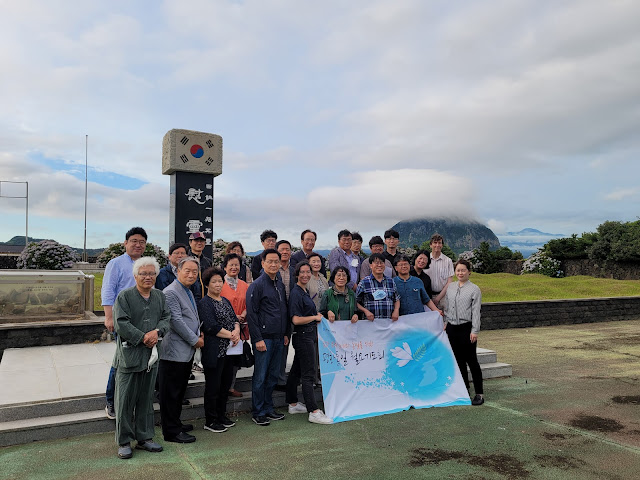At the end of June I was privileged to fly to the island of Jeju to participate in a commemorization of the Jeju uprising and massacre hosted by Jeju Presbytery for leaders of the PROK. Along with Moderator Rev. EunKyong Kim, General Secretary Rev. Changju Kim, and several other leaders from the PROK General Assembly, I got to see with my own eyes many of the sites on Jeju Island where some terrible atrosities and violations of human rights took place seven decades ago.
To most Koreans, Jeju is an island paradise, a holiday destination with beautiful beaches and mountains, but it has a painful history. For a long time the truth of the massacres that took place between 1947 and 1950 was suppressed by the South Korean government. Even the offical title for the event—“the Jeju 4.3 Incident”— reflects this contested history in that it makes it sound like it was a single isolated event that took place by accident. But during this time period at least 30,000 Jeju Islanders lost their lives in a brutal government crackdown—about 10% of the island’s population.
The April 3 Incident began during the March 1 Independence ceremonies in 1947. The Jeju islanders were protesting the division of the Korean Peninsula into North and South. A boy was injured by the police and left wounded. Crowds protested against the police. Six people were shot. Things escalated during the coming days and months. Three hundred villagers from Bukchon-ri were slaughtered by the police in January 1949. Forty villagers from Seonheul-ri hiding in Moksimul cave were massacred by the army in November 1948. Other atrocities took place at other sites . Whole villages - men, women, and children - were burned. They continue to find bodies in various places throughout the island.
My Korean language skills are still not all that good, so as we went around to the various sites I was not always able to understand everything that was said. But I could understand the body language. The grief Koreans feel about what took place on Jeju is immense. One understandable reaction to such intense feelings is denial: wouldn’t it be better to just forget and move on? Why open old wounds? Isn’t it better to pretend it never happened? But such reactions are a betrayal of all those who lost their lives.
One of the most powerful moments for me was standing in a hollow where bodies had been dumped. It was August 1950. It was looking imminent that the North Korean army would be able to reach Jeju. The police at Moseulpo took prisoners out of the police station and lined them up, and then shot them, piling up the bodies in the hollow. And then tried to destroy the evidence, burying the bodies in secret so that the outside world would not know. But the world did find out. Since the year 2000, despite the passage of time, this and many other actions of the authorities at that time have been painstakingly documented and now put on display.
One of the things that I have discovered since coming to Korea is that many of the events of Korea’s recent history are still very much contested. It took decades for the government to acknowldge that something wrong took place on Jeju and even now there are people who continue to be in denial about it. Those who were responsible for the massacre, most of whom are now dead, were never held to account. For this reason, it was all the more important for leaders of the PROK to make this special trip to Jeju this year to see and hear what took place, and to commemorate the incident. By remembering, by touching and seeing and hearing, by standing in the places where the events took place, the reality of the atrocities are brought home, even in the face of denial. Being part of the delegation allowed me too to participate in this important work of commemoration.
As unpleasant as it may be, documenting the truth, commemorating the events year after year, the intentional act of remembering: these are all necessary steps for preventing it from ever happening again. Please remember all those who lost their lives during the April 3 uprising and massacre. Pray for their families and for the people of Jeju, and for all those in today’s world who are suffering similar brutality and struggling for justice.
 |
| At the 4.3 Memorial Peace Park: remembering the dead |
 |
| The group heard many stories of what took place |
 |
| We trekked through the bush to reach burial sites |
 |
| Inspecting a spot where bodies had been dumped |
 |
| At the 4.3 Memorial Hall, the Moderator of the PROK, Rev. EunKyong Kim, signs the register on our behalf |



Comments
Post a Comment